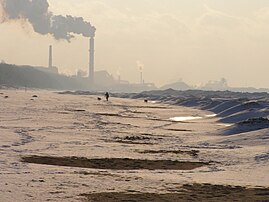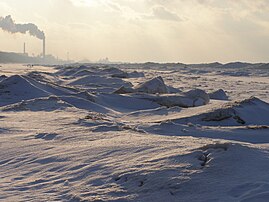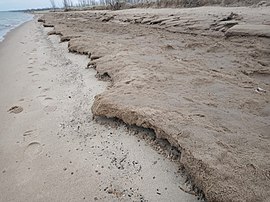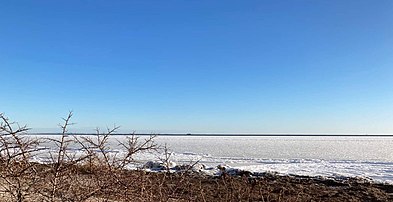Shelf ice

Shelf ice is ice that forms when a portion of a lake surface freezes. It is often then washed upon the shore. The phenomenon is common within the Great Lakes.[1]
Formation
[edit]Shelf ice forms from float ice. Float ice is like drift ice, but seldom becomes large enough to support humans or large animals. The cold temperatures freeze small areas of the open lake, forming float ice. Similar ice will form along the shoreline when the lake is calm. Over time, the ice will build up from continued freezing on the open lake and from snow accumulation on the surface. The surface of the Great Lake seldom remains calm enough for the entire surface to freeze. However, the smaller lakes, Lake St. Clair, Lake Erie, and Lake Ontario will freeze over more often than the larger upper lakes. The wind pushes the float ice and creates waves which also move the ice. Over time, the ice will accumulate on the leeward shores of the lake. Like sand, which is moved by the wind and the waves, the ice begins to accumulate along the east and southern shore of Lake Michigan. When pushed onto the beach, it remains and over time, the ice accumulates on top of the beach and the ice already pushed ashore.
On days with a strong off-shore wind, an ice sheet may reach out into the lakes as far as the eye can see. But across the lake, there is likely to be open water several miles wide.
Structure
[edit]Shelf ice is a floating mat of ice, but unlike a pond or a small lake that freezes over, the shelf is not a uniform sheet of ice. Created by the wind and waves, the shelf ice is a jumble of ice chunks, pushed onto each other. It is as if you took a pile of rubble and pushed up against a wall. The more you push, the narrow the pile becomes, and it rises in a ridge. But there is nothing stable in the pile. The individual pieces (ice in the case of shelf ice) are not initially connected; they only float upon the water surface and rest upon each other. Many become jammed together but throughout the structure, there are pockets of air. Since each piece of ice developed independently, each is of a different thickness, creating variations in strength, density, and depth.
Over time, the 'shelf' extends out from the shore in a long-lasting floating ledge. The ledge can become very thick depending on the size of the ice pieces and the size of the air pockets. The ice sheet can be stabilized by grounding on shore or lake bottom, through additional freezing from seaspray, precipitation and undersurface ice formation and through melt/refreezing cycles from solar heating and weather variations. Therefore, an ice shelf can vary from a large flat surface to a jumbled pile of blocks with parallel ridges.
When a 'shelf' extends out to a sand bar, a ridge will form that is higher than the rest of the shelf. If there is more than one sand bar along a beach front, the ice shelf will form a ridge along each sand bar.[citation needed]
Dangers
[edit]Because of the uneven surface and possible air holes throughout shelf ice, the ice may give way unexpectedly. One can plummet several feet through an air pocket into open water.[2] Self rescue is difficult due to the friability of the ice and the rate at which the cold water will sap energy.
Gallery
[edit]-
Southern Lake Michigan beach in winter at Indiana Dunes National Park
-
An unbroken stretch of shelf ice at Indiana Dunes National Park
-
Ridges of shelf ice along Lake Michigan's southern shore at Indiana Dunes National Park
-
Remnant shelf ice covered with sand and undergoing gradual denivation on a Lake Michigan beach
-
Shelf ice build up on the Sound North of Copenhagen
See also
[edit]References
[edit]- ^ Hillman-Rapley, Lynda (2017-02-03). "Walking on shelf ice can be deadly". Exeter Lakeshore Times-Advance. Retrieved 2020-02-05.
- ^ Phil Schwarz (2018-02-19). "Dangerous shelf ice forms along Lake Michigan". abc7chicago.com. Retrieved 2020-02-05.
Text is available under the CC BY-SA 4.0 license; additional terms may apply.
Images, videos and audio are available under their respective licenses.





